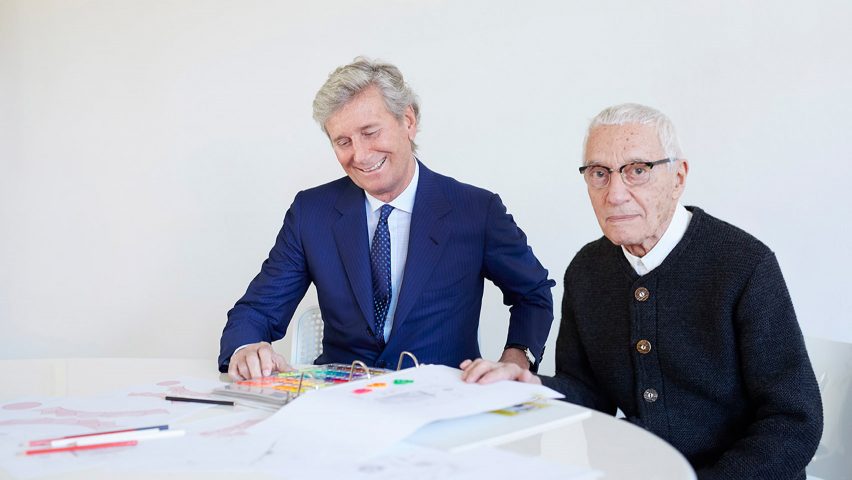Alessandro Mendini, the Italian designer, theorist and editor who passed away this week, speaks to Dezeen about how design magazines have lost their critical edge in this interview recorded in 2015.
Dezeen editor-in-chief Marcus Fairs interviewed Mendini at the Salone del Mobile, where the designer was that year launching two new products with Italian design brand Kartell. He told Fairs there was "no more ideology" in design today.
The designer, famed for influential works of architecture and design including the Proust armchair and the Groninger Museum, passed away 18 February 2019 aged 87.
He was himself an influential theorist, serving as editor of Italian design magazines Casabella, Modo and Domus in the 1970s and 80s.
"If I would do a magazine now, it would be impossible," he said. "The magazines on paper I think could now be good documents, but not in a critical way."
Below is a transcript of the interview with Mendini:
Marcus Fairs: Tell me about the two products you've designed for Kartell. I understand you've been friends with Kartell president Claudio Luti for a long time.
Alessandro Mendini: I was the editor of a magazine. The name of the magazine was Modo. The offices of Modo were inside the Kartell factory. So for five years I went there every day and I got to know all the people there. And I met the young Claudio Luti there. And then for 30 years we never met again.
Then some months ago we met in Florence because I won a prize, and he presented the prize. And he told me we should do something together. So I designed some objects, sketches. We talked about the sketches, he chose the stool and very, very quickly – too quickly! – we designed it.
Marcus Fairs: Why is it influenced by Roy Lichtenstein?
Alessandro Mendini: Because my way of working is to find a relationship with people that I like. So for example, I don't know if you know my Proust chair? It has a strong a relationship with Proust, with Pointillism. So I also like the work of Roy Lichtenstein. But I'm interested also in tradition.
For example the Proust Chair is a Baroque shape mixed with Pointillism. Two very different situations. The shape of this stool is Chinese; a Chinese ceramic stool. I mixed Lichtenstein and the Chinese stool together. It's a kind of serious play.
Marcus Fairs: Is there an intellectual relationship between Lichtenstein and the Chinese stool? Or is it just for fun?
Alessandro Mendini: For me it is not only fun, because it's a very precise method of working. I connect shapes with the pattern of painters in a very methodic way. It's a method.
Marcus Fairs: The Proust chair was revolutionary. Tell me the story of that chair.
Alessandro Mendini: Well. It was 1978 and I wanted to realise a very enigmatic object: not painting, not industrial design, not sculpture, but something very mixed. I'm really interested in transforming the objects in novels; it's a literary way of doing design. The objects are like personalities; all my objects are like characters. One is good, another one is bad. It's a kind of comedy and tragedy.
At that time my attention was to think what could happen if I made a chair for Mr Proust. I designed also a stool for Giotto and a table for van Gogh.
Marcus Fairs: Did you approach designing a chair for Proust as a serious, functional task? Or was it an intellectual exercise?
Alessandro Mendini: It was an intellectual exercise, because this chair is very expensive, it has no function. It's only for amusement. But Pointillism is a real theory. Because if each point is good, the whole object is good. Also in society: if each person is good, the society is good. And the Pointillism – I did a lot of work in mosaic. Because you can incorporate all the world in this small, square piece of glass.
Marcus Fairs: What would Proust say if you gave him the chair?
Alessandro Mendini: [Long pause] Proust did not have good taste in furniture.
Marcus Fairs: So would he like it? Or not?
Alessandro Mendini: Maybe he would like it! [Laughs]
Marcus Fairs: You spent a lot of time working on magazines. What is the role of the media in design today? We have digital media; websites like Dezeen. People are talking about the death of the critic and the rise of the short-attention span due to social media. What is the place of a magazine, of the media, in today's design world?
Alessandro Mendini: I can answer like this, because I worked for three magazines. The first one was Casabella, the second was Modo and the third was Domus. They corresponded to very precise ideologies: radical design at Casabella; interdisciplinary at Modo; and Postmodernism at Domus. The way of realising the magazines was very precise, because the design [ideology] was strong.
Now there is no more ideology. All the world is very confused, all the world is very violent. There are too many different possibilities. So if I would do a magazine now, it would be impossible. Then also there is the crisis of the paper, so for magazines printed on paper, it's a very bad time. The magazines on paper I think could now be good documents but not in a critical way.
Marcus Fairs: You mean like a catalogue?
Alessandro Mendini: Yes. Which is important too.
Marcus Fairs: What do you think about digital media?
Alessandro Mendini: I'm sure it is a very important thing but I don't use it at all. I write with a pencil.

